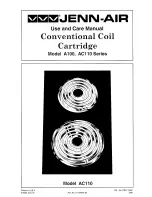
8
necessary and then combine with
remaining ingredients in cooking pot.
Cover and refrigerate. When ready to
cook, place the cooking pot in the cold
multicooker and add 30 minutes to your
projected cooking time.
• To decrease the amount of fat in recipes,
remove as much of the visible fat as
possible from meats and poultry.
Remove skin from poultry and drain any
fat from browned meats.
• Dried beans should be soaked overnight,
then brought to a boil, drained and
rinsed before cooking. Do not add salt or
any acid to beans when cooking, as it
will prevent them from softening
completely. Dried beans can be cooked
ahead, drained and frozen. Thaw to add
to your favorite recipes.
Adapt your own recipes to slow cook:
• For recipes that do not require Brown/
Sauté or Roast function before slow
cooking, reduce the cooking liquid by at
least 50% (soups are the exception).
Liquids do not evaporate as they do in
traditional cooking, and most often you
will end up with much more liquid than
you began with.
• When converting a traditional slow cook
recipe that incorporates the Brown/Sauté
or Roast function first, the liquid amount
will need to be increased. Every recipe is
different. Our approximate guideline is to
double the liquid for a long braise and
increase it by about 50% for a soup or
stew. Also, set the slow cook time to the
lower end of the recommended time
range.
• Certain cuts of meat are more appropriate
for slow cooking. Lean cuts such as
boneless, skinless chicken breast or pork
tenderloin may seem dry if slow cooked.
See our suggestions on page 9 for more
information.
• Dairy products (milk, sour cream, some
cheeses) will break down and curdle
during slow cooking. Substitute canned
evaporated milk, nonfat dry milk, or add
dairy products during the last 30 minutes
of cooking.
• When making soups, add solid
ingredients to multicooker and then
liquid to cover. If a thinner soup is
desired, add more liquid to taste when
finished.
• If your recipe calls for precooked pasta,
UNDERCOOK it and add to the pot in
the last 30 minutes of slow cooking. The
same goes for rice. Add precooked rice
in the last 30 minutes of cooking.
STEAMING TIPS:
• Steaming is one of the healthiest
methods of cooking, as the smallest
amount of nutrients are lost in the
cooking process.
• To steam, fill the multicooker pot with
1 quart of water unless otherwise
indicated.
• When adding heavier foods like corn
on the cob to the steaming rack, place
them on the middle of the rack and work
your way to the edges.
• There are some instances when it is best
to add ingredients to the rack before
preheating, such as delicate food like
dumplings or tamales.
• Always use caution when removing lid. It
is best to remove the lid away from you.






























